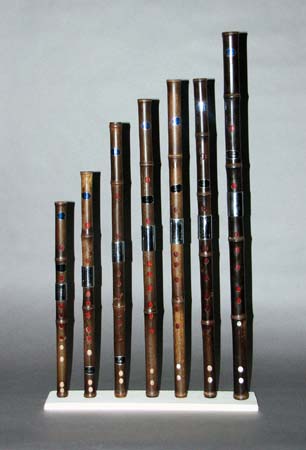
Owner: HWMC
Catalog#: AS-AEBH-02-14
AS-AEBH-03-14
AS-AEBH-04-14
AS-AEBH-05-14
AS-AEBH-06-14
AS-AEBH-07-14
AS-AEBH-08-14
Edge-blown Flutes
China ‘Di’ (Flute Set)
China, Taiwan
Chinese & Twainian
Bamboo, metal, paint
Mid 20th century
Length range: 26.5 in to 10.25 in
Aerophones – Edge-blown Flutes
The di (dizi) has regional varieties, including the two most prominent traditions: The quci, a medium-range flute mainly used for southern schools (Nanpai), and the bangdi, a shorter and high-range flute mainly used for northern schools (Beipai). The difference between these traditions is reflected in the differences of style, repertoire, and technique.
The di (dizi) is also one of the few wind instruments in the Confucian ceremonial orchestra, although many shrines were destroyed before and during the Cultural Revolution (1966-76). Nevertheless the ritual was introduced and maintained in Taiwan, in which the di (dizi) is mainly used for Confucian sacrificial ceremony (Jikong Dianli). As some Han regional genres were introduced to Taiwan during the eighteenth century, the di (dizi) has been widely used in several localized Han music traditions in Taiwan, such as Beiguan and Hakka Bayin.
This twentieth-century set of di (dizi) of varying lengths has repositioned holes to accommodate new concert hall repertory with expanded pitch ranges and fingerholes positioned to produce whole-tone and half-tone intervals.
Resource: Chinese flutes – Eddie Chia-Hao Hsu (eddiehmusic.com); “Di,’ Alan R. Thrasher, “The Grove Dictionary of Musical Instruments,” 2nd ed. Vol 2., Laurence Libin, Editor in Chief. Oxford University Press.
